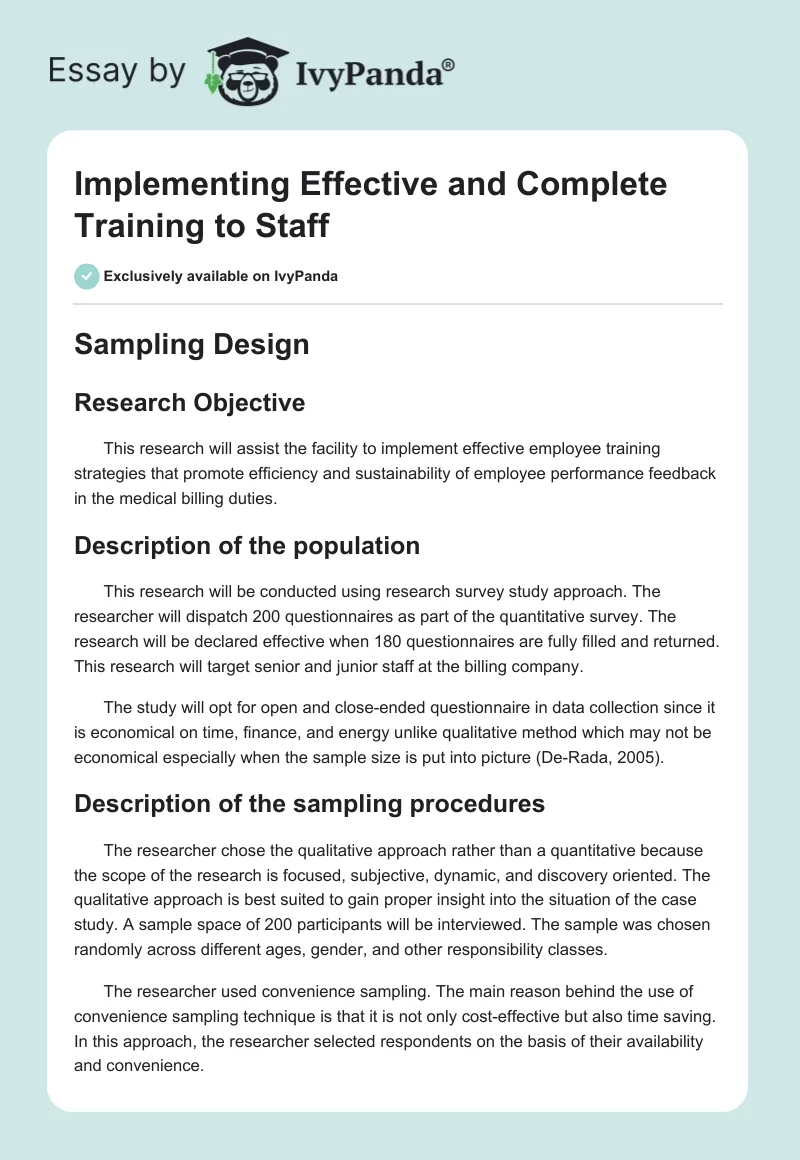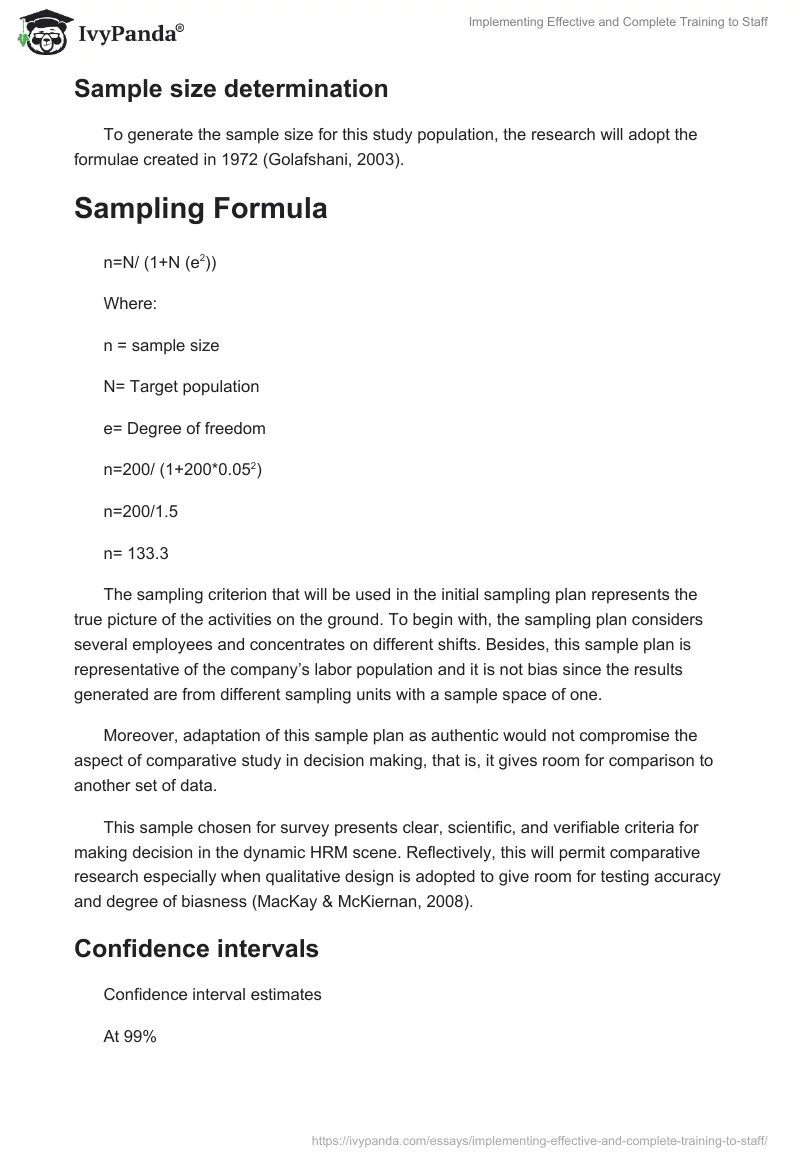Sampling Design
Research Objective
This research will assist the facility to implement effective employee training strategies that promote efficiency and sustainability of employee performance feedback in the medical billing duties.
Description of the population
This research will be conducted using research survey study approach. The researcher will dispatch 200 questionnaires as part of the quantitative survey. The research will be declared effective when 180 questionnaires are fully filled and returned. This research will target senior and junior staff at the billing company.
The study will opt for open and close-ended questionnaire in data collection since it is economical on time, finance, and energy unlike qualitative method which may not be economical especially when the sample size is put into picture (De-Rada, 2005).
Description of the sampling procedures
The researcher chose the qualitative approach rather than a quantitative because the scope of the research is focused, subjective, dynamic, and discovery oriented. The qualitative approach is best suited to gain proper insight into the situation of the case study. A sample space of 200 participants will be interviewed. The sample was chosen randomly across different ages, gender, and other responsibility classes.
The researcher used convenience sampling. The main reason behind the use of convenience sampling technique is that it is not only cost-effective but also time saving. In this approach, the researcher selected respondents on the basis of their availability and convenience.
Sample size determination
To generate the sample size for this study population, the research will adopt the formulae created in 1972 (Golafshani, 2003).
Sampling Formula
n=N/ (1+N (e2))
Where:
n = sample size
N= Target population
e= Degree of freedom
n=200/ (1+200×0.052)
n=200/1.5
n= 133.3
The sampling criterion that will be used in the initial sampling plan represents the true picture of the activities on the ground. To begin with, the sampling plan considers several employees and concentrates on different shifts. Besides, this sample plan is representative of the company’s labor population and it is not bias since the results generated are from different sampling units with a sample space of one.
Moreover, adaptation of this sample plan as authentic would not compromise the aspect of comparative study in decision making, that is, it gives room for comparison to another set of data.
This sample chosen for survey presents clear, scientific, and verifiable criteria for making decision in the dynamic HRM scene. Reflectively, this will permit comparative research especially when qualitative design is adopted to give room for testing accuracy and degree of biasness (MacKay & McKiernan, 2008).
Confidence intervals
Confidence interval estimates
At 99%
Sample statistic + Z value × standard error / √n
b1 = 7.1175 ± 2.57 × 0.9631 / √133
= 7.1175 ± 2.57 × 0.9631 / 11.5326
= 7.1175 ±0.2146
= 6.9029 ≤ b1 ≤ 7.3321
At 95%
b1 = 7.1175 ± 1.96 × 0.9631 / √133
= 7.1175 ± 1.96 × 0.9631 / 11.5326
= 7.1175 ± 0.1635
= 6.954 ≤ b1 ≤ 7.281
At 90%
b1 = 7.1175 ± 1.64 × 0.9631 / √133
= 7.1175 ± 1.64 × 0.9631 / 11.5326
= 7.1175 ± 0.1368
= 6.981 ≤ b1 ≤ 7.254
The confidence interval estimate of 90% is 6.981 ≤ b1 ≤ 7.254, of 95% is 6.954 ≤ b1 ≤ 7.281, and of 99% is 6.9029 ≤ b1 ≤ 7.3321. Thus, it can be noted that as the interval level decreases, the confidence interval estimate increases.
Different biases and minimization
The responses from the participants will be analyzed to determine which research question and research objective they are addressing. They will then be coded accordingly. One major weakness of this data analysis method is that it tends to transform qualitative data into semi-quantitative data by giving it labels and tags.
In this case, the qualitative data will be tagged and labeled according to the research question and research objective they address. In addition, it tends to leave out information that does not correspond to the themes identified by the researcher.
However, a major strength of the methodology is that it helps in analyzing all themes, which have implications on the research questions; hence the bias will be minimal. In spite of its inability to highlight themes that are external to the research questions conclusively, the methodology is appropriate for this study (Golafshani, 2003).
In other words, the researcher will study the texts from the data collected trying to identify the concepts that relate to the research questions and objectives. Content analysis and thematic analysis are closely related, especially in the context of the current study. Both of them are hinged on the research questions (MacKay & McKiernan, 2008).
Conclusion
The evaluation methodology will be used in completing this paper. The research design will be a mixed-methods blueprint, emphasizing strategies from a qualitative model and the use of subjective human interpretation in the evaluation process.
The population sample was identified as 200 employees of the billing company. A sample size of 133 employees will be selected. The data analysis techniques to be used were highlighted. The use of coding, thematic analysis, and content analysis in the study was justified.
References
De-Rada, V. D. (2005). Influences of questionnaire design on response to mail surveys. International Journal of Social Research Methodology, 8(1), 61-78.
Golafshani, N. (2003). Understanding Reliability and Validity in Qualitative Research. The Qualitative Report, 8(4), 597-607.
MacKay, B., & McKiernan, P. (2008). The role of hindsight in foresight: refining strategic reasoning. Futures, 36(3), 161-179.


